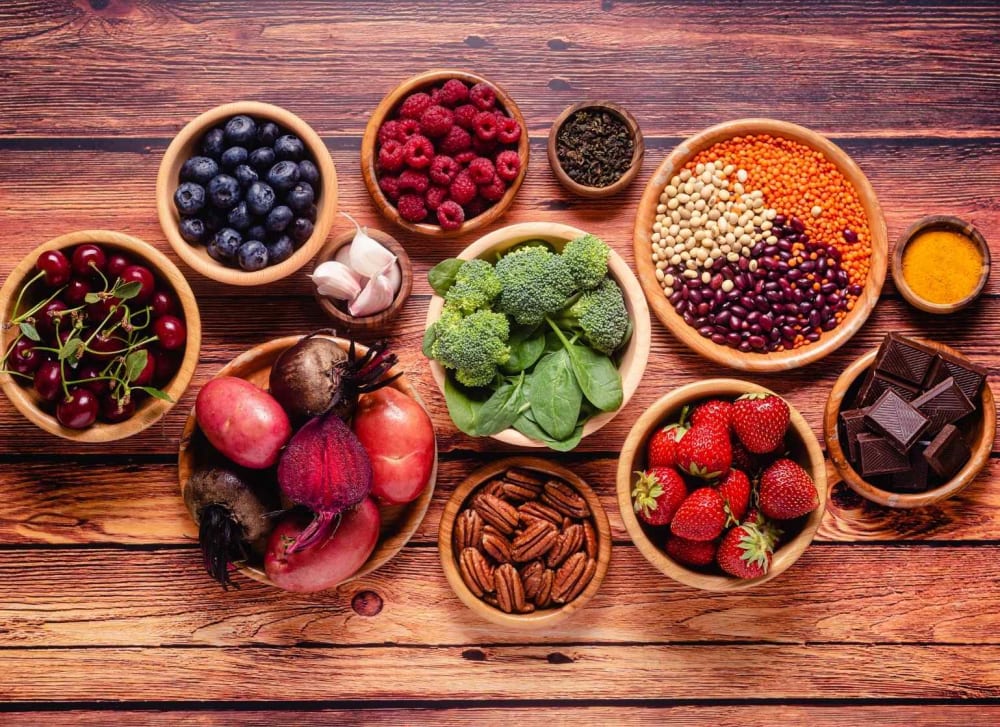
It is possible to reduce inflammation by eating a diet high-in fruits and veggies. At least nine portions of these foods should be eaten each day. Fresh fruit should be consumed, especially if it is high in antioxidants like strawberries. Whole grains are essential. But, you should limit your intake of rice noodles to once a week. Baking flour is not an anti-inflammatory food. These foods are good for your energy and can prevent inflammation.
A diet high in green leafy vegetables is a good choice to promote good health. This will increase your intake of omega-3 fat acids and reduce inflammation. Organic meat and dairy products are also options. You can also choose omega flax or fish oil for your dietary fats. Choose olive or sesame oil as they are both healthy and rich in vitamin E.
Inflammation can also be controlled by eating whole foods. Consume foods without added sugar. The best foods to eat are fruits and vegetables. Healthy diets include low-fat dairy products and nuts, seeds, oil, and olive oils. Your food can be enhanced with spices and herbs. The addition of antioxidants and vitamin E to your dishes can help reduce free radicals.

While there is no cure for inflammation, there are some things that you can do to reduce your risk of this condition. A healthy diet should include plenty of fresh fruits and vegetables, and try to avoid processed foods and sugary foods. Coconut oil and fatty fish are also good choices. You'll be healthier, and less susceptible to inflammation, if you eat these foods. If you want to have more anti-inflammatory foods in your diet, you can check out EverlyWell's vitamin D and high sensitivity CRP test kit.
Although there are not many scientific studies to support this assertion, there is evidence that inflammation can be reduced in many cases. It can prevent chronic diseases, such as cancer and heart disease. Inflammation is part of the body's natural process. It is normal and healthy. Your diet can help reduce inflammation. This article will help you reduce your risk of developing chronic illnesses.
Your health is directly affected by the foods you eat. Quercetin, which inhibits the production histamines, is found in onions. Anthocyanins, which are found in berries, help to reduce inflammation. You can still eat foods high in flavones, anti-inflammatory compounds and other nutrients. Include whole grains, berries and fruits in your diet.
Many factors can cause inflammation. Chronic inflammation is caused by many factors including excess weight, poor sleep and pollution. Drinking a balanced diet with plenty of water and anti-inflammatory foods will help reduce your risk for chronic inflammation. Healthy eating habits are important for maintaining a healthy lifestyle. Anti-inflammatory foods can help maintain a healthy body.

There are many reasons why inflammation can occur in the body. If your body is not used to inflammation, it can contribute to chronic pain, ear infections, and even cancer. Consuming foods high in polyphenols like blueberries and leafy vegetables is the best way to reduce inflammation. You may also benefit from the anti-inflammatory properties of coffee, which can help to protect your health. It is possible to improve your diet and get enough sleep.
Chronic inflammation is directly related to your diet. Many people suffer from chronic health problems due to their diet. While inflammation is a natural body response to injury it can also cause serious health problems. A diet high in refined carbs can cause inflammation. Soda and some other foods can be very harmful for your body. They can cause pain in the joints, fatigue, and other symptoms. They can also encourage the growth of cancer and other cardiovascular diseases.
FAQ
How often should I exercise
Fitness is key to a healthy lifestyle. However, there isn't a set amount of time you must spend working out. Finding something that you love and sticking with it is the key.
When you exercise three times per week, aim for 20-30 minutes moderate intensity. Moderate intensity means that your muscles will continue to work hard even after you finish. This type workout burns about 300 calories.
You can walk for 10 minutes every day if that is what you prefer. Walking is easy on the joints and has low impact.
Jogging is an alternative to running. You can do it for as little as 15 minutes each day. Running is a great exercise to build muscle tone and burn excess calories.
Begin slowly if your are not used to working out. Start by doing 5 minutes of cardio each day, a few times per week. Gradually increase your cardio time until you reach the goal.
Is cold a sign of a weak immune response?
It is said that there are 2 types of people: those who love winter (and those who hate it). It doesn't matter if you love it or not, it is possible to wonder why it makes you feel so miserable when it gets cold outside.
The truth is that our bodies are built to work best when it's warm. Because of this, our bodies evolved to thrive and survive in hot climates.
Now, however, we live in a completely different environment to how our ancestors lived. We spend more time indoors and are often exposed to extreme temperatures (cold or heat) and eat processed foods rather than fresh.
This means that our bodies aren’t used to these extremes. That means that when we do venture outdoors, we're left feeling tired, sluggish, and even sick.
These effects can be reversed, however. One way is to make sure that you stay well-hydrated throughout the day. Water is essential for your body to function properly and eliminate toxins.
It is important to eat healthy foods. Eating nutritious foods helps your body maintain its optimal temperature. This is especially helpful for people who spend a lot of time indoors.
Finally, consider taking a few minutes each morning to meditate. Meditation helps to calm your mind and body which can make it easier to deal stress and illness.
What is the difference between fat and sugar?
Fat is an energy source from food. Sugar is a sweet, naturally occurring substance in fruits and vegetables. Both fats and sugars provide the same number of calories. Fats have twice the calories of sugars, however.
Fats are stored within the body and can contribute to obesity. They cause cholesterol buildup in arteries which may lead to heart attacks and strokes.
Sugars provide instant energy and are rapidly absorbed by the body. This causes blood glucose to rise. High blood glucose levels are dangerous as it can increase the likelihood of developing type 2 diabetes.
How can I get enough vitamins
The majority of your daily needs can be met through diet alone. Supplements may be necessary if you are not getting enough of a particular vitamin. You can take a multivitamin supplement that contains all the vitamins you need. You can also buy individual vitamins in your local drugstore.
Talk to your doctor if you have concerns about your nutritional intake. You can find vitamins K and E in dark green leafy vegetable such as spinach, kale and turnip leaves, as well a variety of sweet potatoes and sweet potatoes.
Ask your doctor if there is any doubt about how much vitamin you should be taking. He or she will recommend the appropriate dosage based on your medical history and current health status.
What is the problem with BMI?
BMI stands to Body Mass Index. It is a measurement of body weight based on height. The following formula can be used to calculate BMI.
Weight in kilograms divided by height in meters squared.
The result can be expressed as a number between zero and 25. A score greater than 18.5 is considered overweight. A score greater than 23 is considered obese.
A person who is 100 kg in weight and 1.75m in height will have a 22 BMI.
What does it take to make an antibiotic work?
Antibiotics are drugs that destroy harmful bacteria. Antibiotics are used to treat bacterial infections. There are many types of antibiotics. Some can be taken orally, others are injected and some are applied topically.
People who have been exposed are often given antibiotics. For example, if someone has had chicken pox, he or she might take an oral antibiotic to prevent shingles later on. Or, if someone has had strep throat, he or she might receive an injection of penicillin to help prevent pneumonia.
Doctors should prescribe antibiotics to children. Side effects of antibiotics can be more dangerous for children than for adults.
Diarrhea is one of the most common side effects of antibiotics. Side effects of antibiotics include diarrhea, stomach cramps and nausea. Most of these symptoms disappear after the treatment is completed.
What are 5 ways to live a healthy lifestyle?
Healthy living means eating right, exercising regularly and getting enough sleep. It also involves managing stress and having fun. Eating well means avoiding processed foods, sugar, and unhealthy fats. Exercise burns calories and strengthens the muscles. Getting enough sleep improves memory and concentration. Stress management reduces anxiety, depression and other symptoms. Fun is the key to keeping us healthy and happy.
Statistics
- According to the Physical Activity Guidelines for Americans, we should strive for at least 150 minutes of moderate intensity activity each week (54Trusted Source Smoking, harmful use of drugs, and alcohol abuse can all seriously negatively affect your health. (healthline.com)
- The Dietary Guidelines for Americans recommend keeping added sugar intake below 10% of your daily calorie intake, while the World Health Organization recommends slashing added sugars to 5% or less of your daily calories for optimal health (59Trusted (healthline.com)
- According to the 2020 Dietary Guidelines for Americans, a balanced diet high in fruits and vegetables, lean protein, low-fat dairy and whole grains is needed for optimal energy. (mayoclinichealthsystem.org)
- WHO recommends reducing saturated fats to less than 10% of total energy intake; reducing trans-fats to less than 1% of total energy intake; and replacing both saturated fats and trans-fats to unsaturated fats. (who.int)
External Links
How To
How to Live a Healthy Lifestyle
A healthy lifestyle involves living a healthy life that is able to maintain your weight, good health, and your fitness level. It's a way of living that includes eating well, exercising regularly, getting enough sleep and avoiding harmful substances such as alcohol, caffeine, tobacco, drugs, and so on. Healthy living can help you feel better about yourself and keep you fit. In addition, a healthy lifestyle reduces your risk of chronic diseases like heart disease, stroke, diabetes, cancer, osteoporosis, arthritis and many others.
The main goal of this project was to provide a step-by-step guide on how to live a healthier life. The first part of the project consisted of writing the introduction, which explains what a healthy lifestyle is, why people should adopt a healthy lifestyle and who we are. Next, I wrote the body paragraphs. These include tips and tricks for maintaining a healthy lifestyle. Finally, I wrote the conclusion. This summarizes the entire article, and provides additional resources, if needed.
I learned how to create a concise and clear paragraph through this assignment. I also learned how to organize my thoughts into topic sentences, and the supporting details. My research skills were also improved as I had to search for specific sources and properly cite them. I learned proper grammar to write.